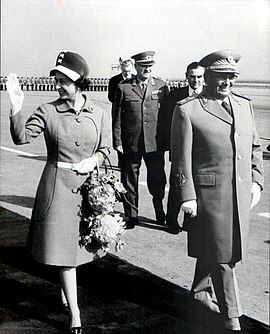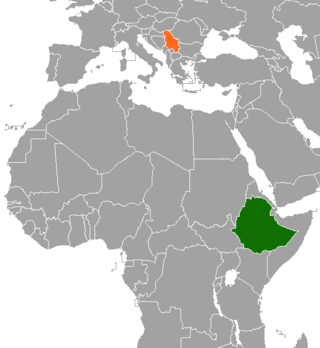
Honorary citizen of Belgrade is a title awarded by the leadership of Belgrade on behalf of the city.

Honorary citizen of Belgrade is a title awarded by the leadership of Belgrade on behalf of the city.
The title can be awarded to both a citizen of Serbia and any other state, as a politician or statesman, as well as a representative of a non-governmental organization or an artist. A candidate for honorary citizenship of Belgrade must have a contribution to the development of science, art, humanitarian activities, etc., which has helped the development and image of Belgrade, the development of democracy in Serbia and the world. The decision to award the title is made by the City Assembly (Parliament). Candidates are nominated by the City Council or at least 10 councilors. [1]
A person who has received the title of honorary citizen of Belgrade is presented with an official letter on official paper at an official meeting of the Assembly. A citizen of Serbia receives it on City Day, and a representative of another country receives it during their visit to Belgrade. [1]

The first to receive this title was General Peko Dapčević on 19 October 1945, who led the liberation of Belgrade in the autumn of 1944. On Yugoslav Youth Day in 1947, the title were given to the head of the Yugoslav Communist Party, Josip Broz Tito, Fyodor Tolbukhin, marshal of the Soviet Union, and Vladimir Zhdanov, general of the Soviet army. [2] [1]
On 19 July 1954 (the year when the title was officially established), for the first time, the leader of a foreign state, the Emperor of Ethiopia, Haile Selassie, became an honorary citizen of Belgrade. Of the foreign leaders after him, the title was awarded to Jawaharlal Nehru, Gamal Abdel Nasser, Norodom Sihanouk, Leonid Brezhnev and others. Despite the warm relations of Josip Broz Tito with a number of leaders of Western European countries, only Elizabeth II, Queen of the United Kingdom, became an honorary citizen of Belgrade during his life (and currently the only woman to be assigned this title). Till 1985, honorary citizens of Belgrade were high foreign officials, who were visiting SFR Yugoslavia. After 1985, the title was not awarded for more than 21 years. The title was reintroduced in 2006. Until 2006, an honorary Belgrade citizen could only become someone who was a senior foreign politician, statesman or military leader. Nelson Mandela received it in 2007. [1] [2]
At the beginning of the 21st century, Bill Gates and Michael Schumacher were nominated as candidates for honorary citizens of Belgrade . Serbian historian Aleksandar Životić explained this by the breakdown of the socialist bloc and globalization, in an era in which society chooses new heroes. [1]
In 2015, Nikita Mikhalkov and Peter Handke are the first artists to become honorary citizens of the Serbian capital. [1]
The list includes people who have been awarded the title of honorary citizen of Belgrade.

Dušan Kovačević is a Serbian playwright, scriptwriter, film director and academic best known for his theatre plays and movie scripts. He also served as the ambassador of Serbia in Lisbon, Portugal.

Matija Bećković is a Serbian poet, writer and academic.

The Order of Karađorđe's Star is the third highest state order of Serbia. The order is awarded by the decree of the President of the Republic on special occasions, typically at the ceremonies held on the Statehood Day. It is awarded for special merits and successes in representing Serbia and its citizens. It can be awarded to individuals and institutions.

Boško Gjurovski is a Macedonian professional football former player who played as a midfielder and a current manager.

Mexico–Serbia relations are the diplomatic relations between Mexico and Serbia. Both nations were founding members of the Group of 77 and the United Nations.

Belgrade Youth Center is a cultural center in Belgrade, the capital of Serbia, dedicated primarily to youth.

Herta Haas was a Slovene and Yugoslav Partisan during World War II and the third wife of Josip Broz Tito, leader of the partisans and a future president of Yugoslavia.

The Museum of Yugoslavia is a public history museum in Belgrade, the capital of Serbia. It chronicles the period of Kingdom of Yugoslavia and Socialist Yugoslavia as well as the life of Josip Broz Tito. Tito's grave is located in one of the museum buildings.

Vladimir Popović Lukin was a Yugoslav diplomat, communist politician and army general. He was a close associate of Josip Broz Tito. He was, during his career, a delegate to the UN, close associate of Josip Broz Tito, Yugoslavia's envoy (ambassador) to the USSR, US, China, and Vietnam, member of the federal government of Yugoslavia, and chair of the Committee for Foreign Affairs of the Federal Assembly of Yugoslavia, and secretary to the presidency until his death in 1972.

The House of Flowers is the resting place of Josip Broz Tito (1892–1980) and Jovanka Broz (1924–2013), the President and the First Lady of the Socialist Federal Republic of Yugoslavia. It is located on the grounds of the Museum of Yugoslav History in Dedinje, Belgrade, Serbia.

Ethiopia–Serbia relations are bilateral ties between Ethiopia and Serbia. Since the time of Yugoslavia, relations between the two nations have been warm. Both Ethiopia and Serbia are majority Eastern Christian nations. Ethiopia is one of Serbia's strongest advocates in Africa when it comes to their position on the recognition of Kosovo.

Stevan Kragujević was a Serbian photojournalist and art photographer.

Kazakhstan–Serbia relations refer to bilateral relations between Kazakhstan and Serbia. Serbia opened an embassy in Astana in June 2011, and Kazakhstan opened a consulate in Belgrade in June 2015.

India–Yugoslavia relations were historical foreign relations between India and now split-up Socialist Federal Republic of Yugoslavia. Yugoslavia established full diplomatic relations with India on 5 December 1948 following the 1948 Tito–Stalin split. Initially two countries developed their relations at the UN Security Council in 1949 during their shared membership. In the period of the Cold War both countries were the founders and among core members of the Non-Aligned Movement.

Ethiopia–Yugoslavia relations were historical foreign relations between Ethiopia and now split-up Socialist Federal Republic of Yugoslavia. Both countries were among founding members of the Non-Aligned Movement. The first contacts between the two countries were established at the United Nations in 1947 where Yugoslavia supported Ethiopian claims on Eritrea while Ethiopia supported Yugoslav claims over the Free Territory of Trieste. After the 1948, Tito-Stalin split Yugoslavia turned towards the non-bloc countries and two countries opened their embassies in 1955. The formal diplomatic relations were established already in 1952. Emperor Haile Selassie was the first African head of state in official visit to Yugoslavia in 1954.

Iran–Yugoslavia relations were historical foreign relations between Iran and now split-up Socialist Federal Republic of Yugoslavia.

United Kingdom–Yugoslavia relations were historical foreign relations between United Kingdom and former Yugoslavia. Relations between United Kingdom and independent South Slavic states developed before creation of Yugoslavia following the decline of the Ottoman Empire.